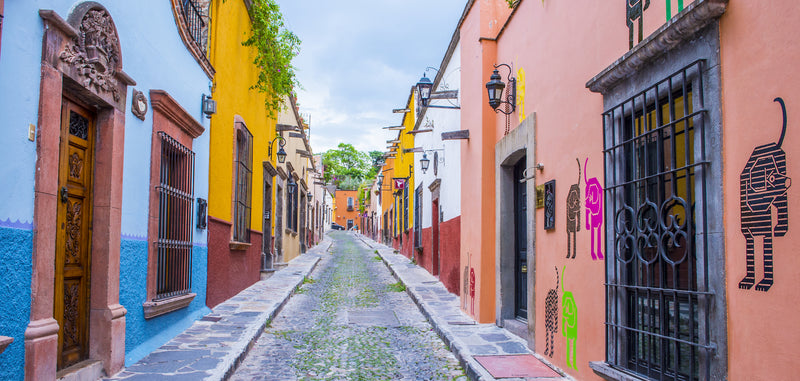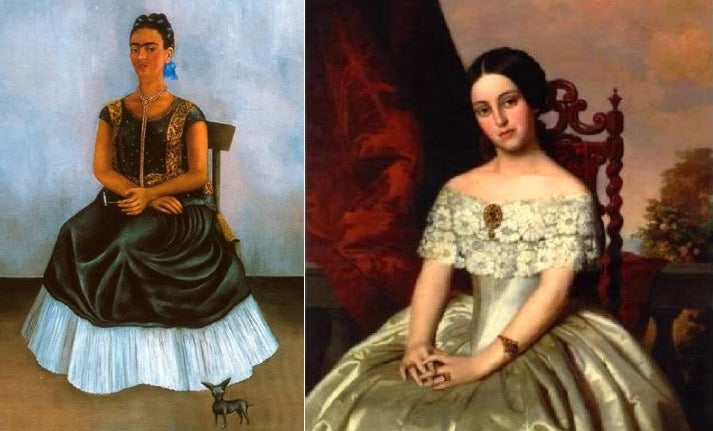Culture and inner life in Frida’s paintings
¿Was Frida's painting style surrealist? It was the description of André Breton when he knew about the work of the Mexican artist. On the contrary, Frida thought she painted a real world, her world. And indeed, her paintings represent a syncretism among the influences of the Mexican culture that she loved so much, with her inner life. Her paintings are a collage of those different influences.
We find in the votive offerings one of the most outstanding examples. An ex-voto is a typical object of Catholicism. It is a gratitude to some patron saint, virgin or Christ in response to a prayer that was fulfilled, many times for having been saved from death, from an illness or from an accident. It was the Spaniards who brought the votive offerings to Mexico. They used it to thank their patron saint in particular when they were saved from a shipwreck. They offered their objects to the sanctuaries. Cortés by himself had given a jewel to the virgin Guadalupe in Extremadura after having survived the bite of a scorpion in his house in Cuernavaca.
Since the seventeenth century, there are examples of New Spain ex-votos (Mexicans of the colonial era) painted and preserved by their owners. Since then, the ex-votos portrayed the scene: the illness or accident, the miracle represented by the image of the saint, or the virgin and a small explanatory text narrating the facts. Over time, votive offerings were reduced in size and became very popular in the 19th century. We know very well the interest of Frida for the Mexican votive offerings because she collected them. We can appreciate part of that collection in the Blue House in Coyoacán.

She painted a single ex-voto as such, or rather repainted an existing one (1943). But she has a whole series of paintings that take up the illustrative universe of the votive offerings. In Henry Ford Hospital (1932) and A Few Small Nips (1935) she takes up the visual language of the votive offering using a lived scene but removes its religious element like the appearance of the saint or the virgin, and replaces it with psychoanalytic elements of the lived traumas, the immeasurable pain related to her accident, the loss of her baby in Detroit before he was born, and Diego's extramarital relations.

Of Frida's extensive work, her portraits and self-portraits stand out. We find the influences, particularly for those painted until the late 1930s, in the painting genre of Mexican portraits of which there is a long tradition. In the colonial period, particularly in the eighteenth century, there was what we call caste paintings. The genre of the portrait evolved in the nineteenth century, particularly under the influence of the director of the San Carlos Academy, the Catalan Pelegrín Clave Y Roque, who took over the institution in 1846 until 1868. He was the teacher of his successor, the painter José Salomé y Pina, one of Diego Rivera's teachers. In other words, Pelegrín was the teacher of Diego's teacher. Therefore, is there a link between the Portrait of a Lady of Pelegrín Clave Y Roque (1847) and the Self-portrait of Frida with dog Itzcuitli (1938)? In the case of Pelegrín, the subject is a lady of the aristocracy as shown by her outfits, her jewels and her pose. On the other hand, Frida painted a chair in a room devoid of decoration, highlighting the simplicity of the place. Otherwise the two paintings are similar. In both cases a portrayed woman is shown seated in a chair and beautifully dressed with her hair pulled back. The Itzcuintle dog is the most visible element of Mexican identity. In the self-portrait dedicated to Leon Trotsky, one of her most beautiful, also known as Between the Courtains (1937), we find again the influence of the painting of nineteenth-century Mexican portraits.

The Mesoamerican, indigenous pre-Hispanic cultural legacy constitutes another major influence in Frida's work, perhaps the most spiritual, the most symbolic and the most profound. Probably, Frida became aware of her deep bond and love of the culture of ancient Mexico in the United States, when she accompanied Diego on his American adventure. The contrast was so strong. In Self-portrait on the border between Mexico and the United States (1932), a very interesting painting, she opposes the cold American technological modernity to the ancestral Mexican culture dominated by the forces of nature, the cycles of life and the fertility of the mother nature. And she chose his side without hesitation, portraying herself again according to the canons of the nineteenth-century Mexican portraits and carrying a Mexican flag in her hand.
She resorted to pre-Columbian symbolism in multiple paintings: through exuberant, exotic, and wild nature; tropical flowers like the bird of paradise; the native fauna, like the monkeys and parrots; and also through her jewels, many times chalchihuites, those semiprecious green stones symbols of wealth and fertility in the pre-Columbian world. A symbolism linked to mother nature, as a protective mother, a great universal womb that gives birth to all beings. They are the paintings of maturity. She has many paintings in the 1940s inspired by the ancient Mesoamerican cosmogony, the life/death, feminine/masculine, day/night dualism. In Little deer (1946), she represented herself as a deer stabbed with arrows, remembering the pre-Hispanic rituals of sacrifice by arrow, being the deer the most emblematic animal of the hunting/sacrifice rituals of the Mesoamerican world.
Last but not least, when Frida paints a still life, the apples and pears, portrayed by the great master Cézanne and admired by Diego Rivera, are replaced by papayas (symbolizing the fecundity of women), soursop, bananas, zapotes, mameyes, pitahayas, all traditional Mexican fruits. Surrealist or not, Frida’s work truly represented her identity and feelings.
About our Author:
Marion Du Bron, Founder of DestinationMEX
 Historian PhD, School of High Social Sciences Studies (EHESS), Paris.
Historian PhD, School of High Social Sciences Studies (EHESS), Paris.
She has lived in Mexico since 2003.
Unconditionally passionate for Mexican history and culture.
Entrepreneur and coach for foreigners.



0 comments